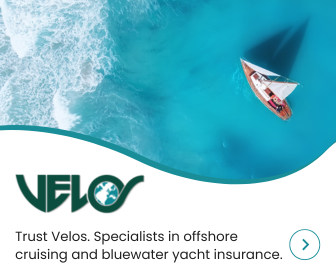New Zealand, Great Barrier Island: A Hidden Paradise
Lying just 90 km northeast of Auckland, New Zealand’s largest city, the Great Barrier Island is easily accessible by boat. Lying on the outer edge of the Hauraki Gulf Marine Park, it is an ideal destination for cruisers who want to experience one of New Zealand’s most unique outer islands. Noonsite’s regional Sub-editor Lynda Lim found out what draws kiwi sailors to an island with a rich natural and cultural heritage on a recent sailing expedition.
Published 6 months ago
Connected yet Remote
New Zealand’s Great Barrier Island – or Aotea – lies at the entrance to the Hauraki Gulf, the Waitemata Harbour and Auckland city, some of the country’s most popular sailing and boating destinations. So when my brother asked if I would like to take a few days off work and sail there with him and my sister-in-law from their home base of Whangamata on the Coromandel Peninsula , I jumped at the opportunity.
I had not visited this island for more than 40 years and it is now – as it was then – an island that attracts those who want to get off the beaten path and away from the stresses and strains of city life.
Great Barrier Island can be reached a ferry from Auckland which takes about 4.5 hours and there are also flights to the island from Auckland and Whitianga on the Coromandel Peninsula.
For sailors, it’s 54NM from Auckland, a good day’s sail depending on wind and conditions. From Whangamata it’s close to 60NM to Tryphena Harbour on the SW corner of Great Barrier Island and a further 13NM to Port Fitzroy. In autumn, with shorter daylight hours, it’s worth taking two days to sail there with an overnight stop at Great Mercury Island. Plus with more settled conditions at this time of year in New Zealand, it is possible to sail up with a SW/S wind, spend a few days exploring Great Barrier Island and then sail back with a NE/N wind.


It has been a few years since I stepped off our catamaran in Darwin, Australia after sailing through Indonesia, so my sea legs were a bit “creaky. However, my brother’s 44ft Pedersen named Argonauta had been around the world before ending up in New Zealand and sailed beautifully the whole trip – so I had nothing to worry about.
Watch the Weather
Having watched the weather pattern and forecast for a few days, the passing of a south-westerly front gave our small flotilla – four yachts and a power boat (all members of the small and friendly Whangamata Yacht Squadron) the right conditions to set off from the Whangamata Marina.
We had all hoped for a leisurely day sail to up the Coromandel coast to Great Mercury Island, the only island where you can anchor among the seven islands in the Mercury Island Group. However, the autumn weather still had a couple of lingering surprises in store. Nevertheless we all arrived safely after dodging a couple of nasty thunderstorms.
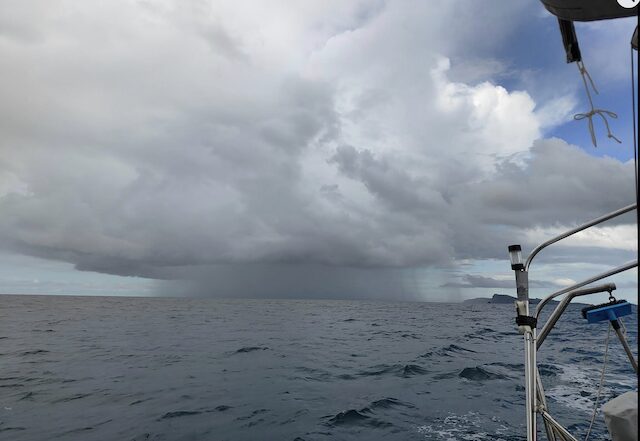

First stop – Great Mercury Island
Great Mercury Island lies 8km off the north-eastern coast of the Coromandel Peninsula and is owned by two of New Zealand’s richest men and backers of the syndicate that won New Zealand’s first America’s Cup.
Huruhi Harbour is protected from all winds and with several moorings available is a popular location for yachts. If you find a free mooring ball, just ring the number written on the side so the owner knows it is being used.
In summer the island is very popular with boats of all shapes and sizes from Auckland and the Coromandel Peninsula and the bays and anchorages get very busy, but in autumn our little flotilla were the only boats there.
If you leave only footprints and take everything away with you – including all your food and rubbish scraps – the owners allow you to land on any of the magnificent white sand beaches to picnic and relax. The island is pest-free and a haven for native birdlife and regenerating flora. You can permit walk over the island, provided you use the turnstiles and leave all gates closed – as parts of the island are still a working sheep and cattle farm.
Anchorages on Great Mercury Island
The island has a number of sheltered anchorages depending on the direction of the wind, all with good sand holding.
The best-known bay and most popular is Home Bay/ Huruhi Harbour at the northern end. The bay has the longest beach on the island and is a perfect anchorage in all tides, but is open to westerly winds. However, you can tuck up into Huruhi Harbour for more protection.
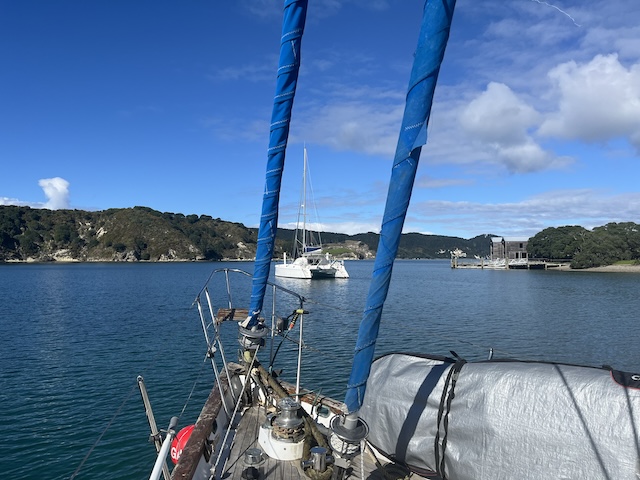

Going round the island in an anti-clockwise direction and you will pass Ahikopua Point, otherwise known as Kingfish Point, where the fishing is reported to be excellent.
On the south coast is Peachgrove Bay which offers an idyllic and safe anchorage at all tides and a wide, expansive beach with plenty of mooring space. There are also excellent smaller beaches with good tidal access on either side, with places like Whale Cove and Momona Bay worth visiting.
Bumper Cove can be good if the wind is blowing from the north, although in all bays, watch out for the shallow reefs that may show only when the tide is low.
Coralie Bay on the eastern side of the island is protected by a shallow rock that is dangerous to those coming from the north, but offers a protected anchorage from west and south winds with a beautiful white sandy beach.
Final stop – Great Barrier Island
The island is entirely off-grid, relying on renewable solar power and private generators and rainwater for everyday life, so if visiting by yacht you’ll need to be self-sufficient and well provisioned. There are stores at Tryphena, the main harbour on the island’s south-west corner and Claris, the main town on the east coast, about 20 minutes by car from Tryphena. There are also regular farmers markets, but most supplies have to be brought in by sea or air from Auckland, so expect prices to be a little higher.
There are around 1200 residents on the island and many more part-time residents and “bach” owners (holiday home owners). There are three primary schools, a medical centre, ambulance, builders merchants, mechanics, council office with a library, and most services required needed to run a small community. However, there is no public transport on the island, but car and e-bike rentals are available and there is a shuttle which operates between Tryphena and Port Fitzroy. The locals are a friendly bunch and hitchhiking is also an option.
Anchoring restrictions on Great Barrier Island
Currently there is a controlled area notice and “rāhui” (In Maori, the word “rāhui” signifies a restriction, prohibition, or ban, particularly related to resources or areas) in place, restricting boats from anchoring anywhere on the west coast of the island including the harbours of Tryphena, Okupu, Port Fitzroy and Whangaparapara, due to an invasive seaweed – Caulerpa Brachypus – that has been found in the waters around the island. This leaves Port Fitzroy as the only harbour on the west coast of Great Barrier Island where anchoring is permitted and that was our destination after leaving Great Mercury Island.
Port Fitzroy
Reached via the Man o’ War passage, watch out for mussel farms and the Auckland to Port Fitzroy ferry, as the passage is spectacular but narrow.
Smokehouse Bay is one of the most popular anchorages due to onshore facilities which have been provided by the boating and sailing community and local families over many years.
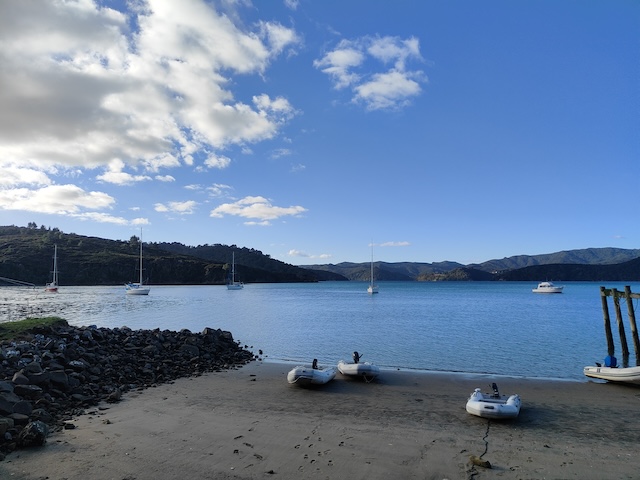

These include a wood-fired pizza oven, barbecue facilities, a smokehouse and a hot tub, powered by firewood. There is usually a pile of wood readily available. If you use the firewood, it is expected that you will replenish the pile from the surrounding forests.


There are many sheltered inlets and coves to choose from, depending on the wind direction. Fuel is available at Port Fitzroy Wharf and there is a small shop up the hill from the wharf which has a small range of supplies.
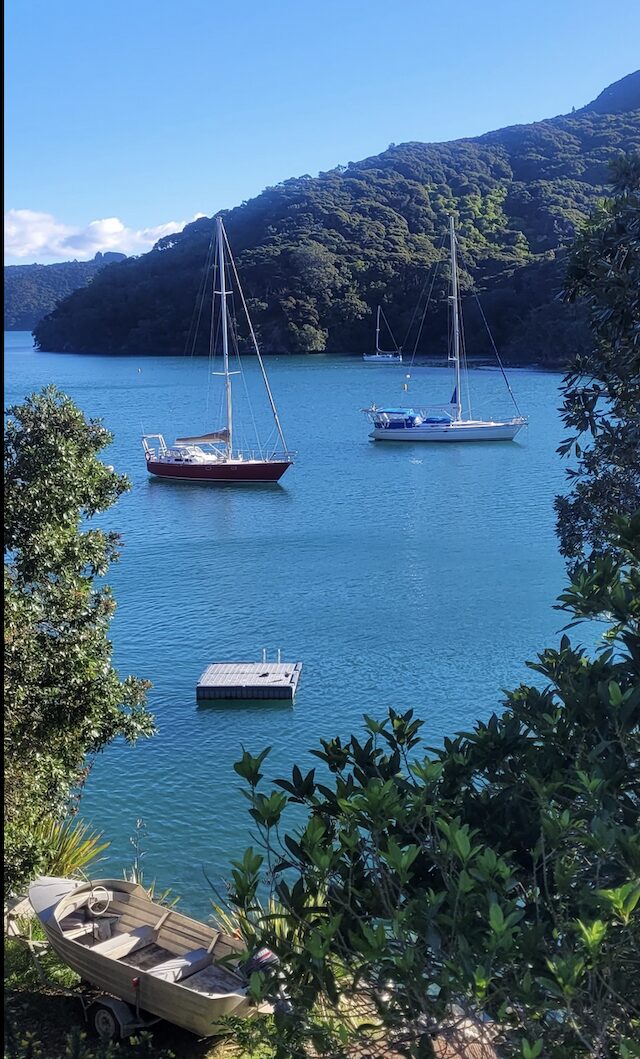

With a focus on conservation, there are many half-day, full-day and multi-day walks that will take you through a diverse and unique natural environment. One of the most popular from Port Fitzroy is to walk to the top of Mount Hobson, the island’s highest point. Along the way you will see remnants of Kauri dams, built by early loggers during the late 19th and early 20th centuries, who milled the magnificent Kauri trees which used to be prolific on the island.
Department of Conservation workers have toiled hard to put in many steps to the top of Mount Hobson – reported to be well over 1000! Once you have reached the top, you can retrace your steps, or continue on to Windy Canyon and to the island’s main road.
Rental cars are available – just ring one of the companies on the island and there will usually be a car available – more than likely you will be told “The keys are under the mat – just leave the money in the glove box when you are finished!
Whangaparapara Harbour
There is a wharf here and fuel is available with a self-service pump – pay by card. Anchoring is not permitted here and there are a few public and some private moorings available so ask a friendly local or contact Peter Gandy, the Harbour Master prior to your arrival. (+64 27 0274227724).
Tryphena Harbour
This is the main harbour on Great Barrier Island and the main ferry terminal from Auckland. From here it’s a short drive to Claris, the island’s main town where you’ll find a supermarket, bakery, bottle shop, museum and the main airport. Rental cars are usually easy to obtain except in summer when the bays and beaches are full of holidaymakers and sailors from Auckland, the Coromandel Peninsula and the rest of New Zealand. Moorings are available as this is a no-anchoring zone and must be reserved well in advance, especially in summer. The Irish Pub comes highly recommended for good food and good company and is probably where you’ll bump into Peter, the Harbour Master.
Not Much has Changed
The island has a laid-back charm and casual friendliness onshore that really hasn’t changed much over the years. Many beautiful bays and harbours attract sailors at all times of the year. Summer gets very busy with holidaymakers, but more settled weather patterns make autumn a good time to visit. Air and water temperatures are still mild, the anchorage areas uncrowded and moorings are readily available. There are many walking tracks throughout the island, which will take you through sub-tropical rainforest and along white sandy beaches.
Lynda Lim
Regional Sub-Editor
Noonsite
SV Argonauta
……………………..
Related Links:
- Aotea – Great Barrier Island Anchoring Restrictions
- Ahuahu – Great Mercury Island Anchoring Restrictions
- Aotea – Great Barrier Island Visitor Information
- Information on private moorings for hire
- Great Mercury Island Visitor Requirements
- Great Barrier Island Visitor Guide
- Hauraki Gulf Islands Map
……………………..
© 2025 Noonsite. This content was edited by Noonsite. Do not reproduce without permission. All rights reserved.
The opinions expressed in this article are the author’s own and do not reflect the view of Noonsite.com or World Cruising Club.
If you have found this information useful, become a paid member to enjoy unlimited use of Noonsite plus many other perks. Your membership fees really help our small, dedicated team keep country information up-to-date in support of cruisers worldwide. Find out more about Noonsite Membership levels and benefits here.
Subscribe to our FREE monthly newsletter: https://www.noonsite.com/newsletter/
Related to following destinations: Auckland, Gulf Harbour, New Zealand, North Island (New Zealand), Whangamata, Whitianga
Related to the following Cruising Resources: Pacific Ocean South, Routing



